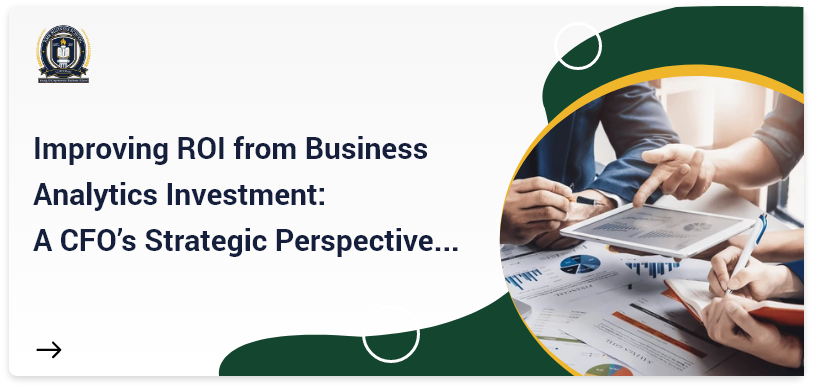Introduction:
Business Analytics at the CFO’s Fingertips
Maximize Business ROI in today’s volatile financial environment, where Chief Financial Officers (CFO’s) face increasing challenges, including risk, uncertainty, and relentless pressure to perform. A significant focus of financial leadership has shifted to business analytics—especially predictive analytics—which has emerged as a powerful tool. Improving ROI from Business Analytics Investment has become a key priority, as it can provide CFOs with a competitive advantage to not only maximize ROI but also to develop proactive growth and risk management strategies, including effective handling of financial risks.
Understanding Business Analytics and Its Relevance for CFOs
What Is Business Analytics?
The application of tools of statistical analysis, data mining, predictive model and data visualization to make sense of business data can be termed as business analytics. It helps organizations to take decisions based on data and get some hidden insights.
Why It Matters to CFOs
The CFO role moved by tradition toward financial report and compliance requires foresight now. The use of business analytics in CFO can enable a transition of financial processes in the roles of CFOs toward more proactive rather than reactive ones by performing the following functions: – Risk anticipation – Maximizing the cash flow – Strategic financial planning alignment.
Measuring the ROI of Business Analytics
Direct Financial Benefits
- Reduced operating costs through better forecasting
- Improved pricing and revenue strategies
- Enhanced allocation of capital investments
Intangible Returns
- Faster decision-making cycles
- Improved cross-functional collaboration
- Better stakeholder communication with real-time dashboards
Aligning Analytics with Strategic Growth
From Insights to Action
For CFOs, analytics isn’t just about monitoring metrics. It’s about integrating these insights into strategic decisions that drive long-term value.
Enhancing Forecast Accuracy
Predictive analytics can project future financial outcomes using historical data, enabling: – Budget accuracy – Demand forecasting – Improved working capital management
Resource Allocation and Optimization
Data-backed insights help CFOs determine which departments, products, or initiatives generate the most value.
Business Analytics and Risk Management
Identifying and Assessing Financial Risk
Analytics platforms identify anomalies, monitor KPIs, and assess historical trends that can signal emerging risks in: – Credit risk – Liquidity constraints – Currency fluctuations
Scenario Planning and Stress Testing
Predictive models simulate “what-if” scenarios to prepare for financial shocks, allowing CFOs to: – Preempt losses – Rebalance portfolios – Adjust cash reserves accordingly
Predictive Analytics: Navigating Uncertainty
The Power of Predictive Models
Predictive analytics is a method of forecasting trends with a non-parameteric statistical algorithm combined with machine learning. In finance, it may include: – Prediction of revenue during economic turbulence – Expectation of customer payment pattern – Inventory or supply chain prediction disruption.
Real-World Applications
- Cash Flow Forecasting: Helps manage liquidity and debt obligations
- Customer Risk Scoring: Assesses potential bad debts before they occur
- Market Trend Prediction: Guides investment strategies
Creating a Data-Driven Culture in Finance
Upskilling Finance Teams
CFOs should invest in analytics training and tools to enable teams to: – Interpret data confidently – Create predictive models – Generate actionable financial insights
Fostering Cross-Functional Collaboration
Analytics flourishes when finance works closely with operations, marketing, and IT, aligning goals and sharing data insights.
Choosing the Right Analytics Tools
Key Features to Consider
- Real-time data visualization
- AI and ML capabilities
- Integration with ERP and CRM systems
Examples of Popular Platforms
- Tableau
- Power BI
- SAP Analytics Cloud
Overcoming Implementation Challenges
Common Roadblocks
- Data silos
- Poor data quality
- Resistance to change
Solutions
- Start small with pilot projects
- Clean and standardize data sources
- Involve key stakeholders early in the process
KPIs to Track Business Analytics ROI
Financial Metrics
- EBITDA growth
- Cost savings
- Forecast accuracy improvement
Operational Metrics
- Decision-making speed
- Productivity of finance teams
- Risk exposure reduction
The Future of Business Analytics for CFOs
Embedded AI and Automation
CFOs can expect increased automation in: – Financial planning – Risk alerts – Budget reconciliation
Data-Driven ESG Reporting
Business analytics will also support Environmental, Social, and Governance (ESG) initiatives through better tracking and reporting.
Conclusion: Business Analytics as a Catalyst for CFO-Led Growth
Not a luxury anymore Business analytics is a necessity to progressive CFOs. CFOs have the ability to deliver highly accurate financial predictions, limit risk and optimize ROI with a suite of tools that provide more predictive forecasting capabilities, sound risk management and ROI optimization options.
FAQs
- How does business analytics improve ROI for CFOs?
By identifying cost-saving opportunities, improving resource allocation, and forecasting market trends, business analytics empowers CFOs to make decisions that directly impact the bottom line. - What is the role of predictive analytics in financial risk management?
Predictive analytics helps CFOs simulate future risk scenarios, assess potential financial threats, and develop proactive mitigation strategies. - How can CFOs start implementing business analytics?
Start with clearly defined objectives, select scalable analytics tools, ensure data integrity, and encourage finance teams to undergo analytics training. - What are the top KPIs for measuring analytics-driven ROI?
Top KPIs include EBITDA growth, forecast accuracy, cost reductions, and decision-making speed. - Which tools are most effective for financial analytics?
Popular tools include Power BI, Tableau, and SAP Analytics Cloud, all offering real-time insights, data visualization, and integration capabilities.






